
- Share via
- Every year, navel orangeworms eat through roughly 2% of California’s almonds before they can make it to grocery store shelves.
- With climate change threatening to make the situation worse, researchers are hoping to sterilize millions of moths a day with radiation and drop them from airplanes.
PARLIER, Calif. — In a windowless shack on the far outskirts of Fresno, an ominious red glow illuminates a lab filled with X-ray machines, shelves of glowing boxes, a quietly humming incubator and a miniature wind tunnel.
While the scene looks like something straight out of a sci-fi movie, its actually part of an experimental program to prevent a damaging almond pest from successfully mating.
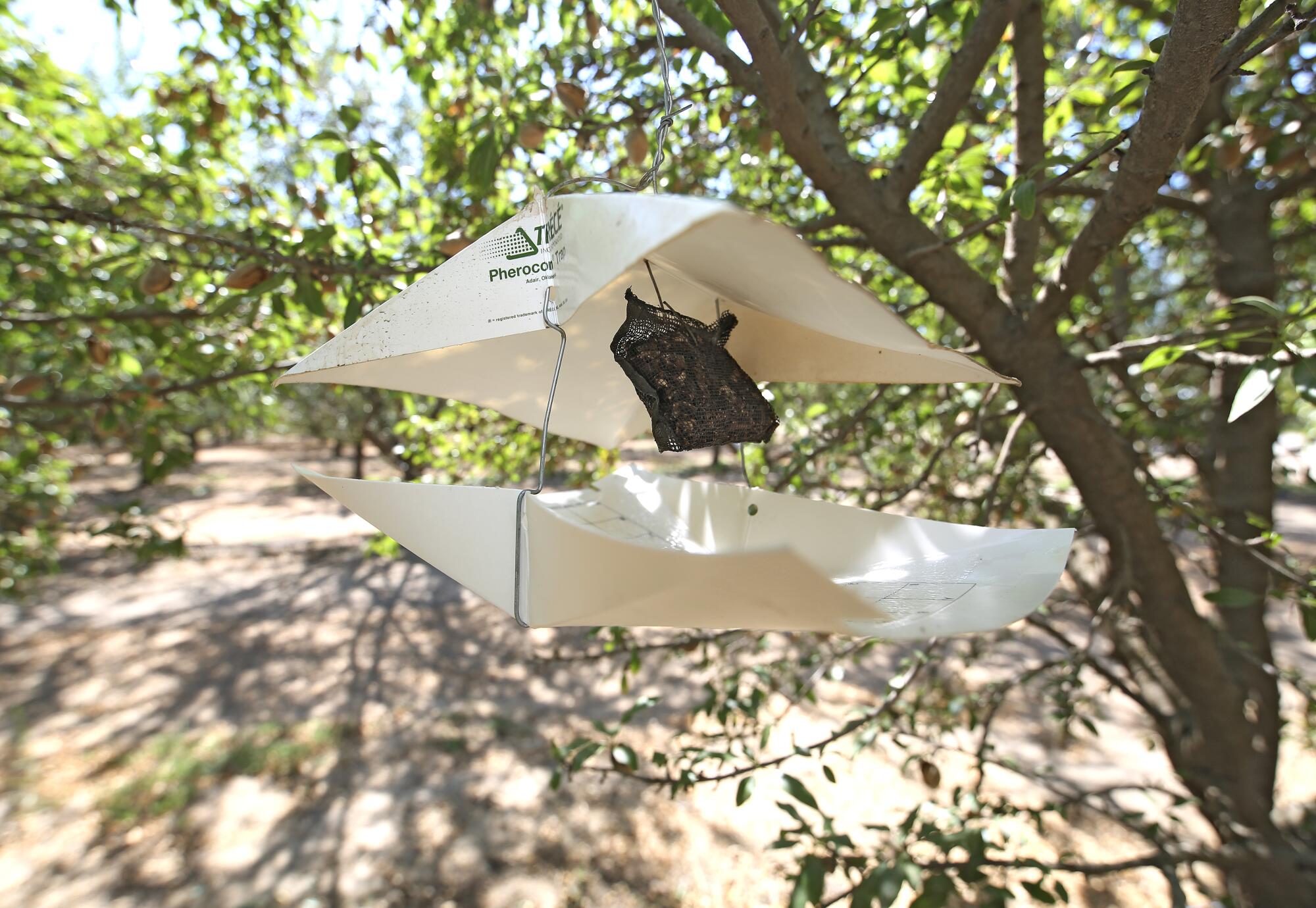
With California almond growers reeling from dropping nut prices and rising costs, the pests have only added to their woes.
Every year, the navel orangeworm eats through roughly 2% of California’s almonds before they can make it to grocery store shelves. Last year, it was almost double that.
While that might seem small, if you do the math “it’s going to be a lot of millions of dollars lost to this pest,” said David Haviland, a Kern County farm advisor with University of California Agriculture and Natural Resources. “And that’s despite the control methods that people use,” he said.
California produces 80% of the world’s almonds, yet in 2022 the production value of the nut fell 34% compared with the previous year.
Scientists say climate change could make the navel orangeworm problem even worse, with hotter temperatures allowing the moths to reproduce even faster. (Despite its name, the insect has largely left citrus farms unbothered and is in fact a moth.)
Traditionally, nut farmers have tackled the insect with chemical pesticides, or by destroying “mummies” — almonds left over after harvest. Mummies are a favorite winter shelter for the bugs.
However, research is increasingly showing that chemical pesticides are not only harmful to the environment but to people as well. One new study found that the impact of nearby pesticide use on cancer incidence “may rival that of smoking.”
A large California almond business has filed for bankruptcy. Low prices are hitting the almond industry after years of rapid growth.
“When you have to don a spacesuit, basically, to apply something, you’re definitely thinking, ‘This is not good,’” said Houston Wilson, a UC Riverside entomology researcher and the mastermind behind the sci-fi shack at UC ANR’s Kearney Agricultural Research and Extension Center.
“Across the board, folks want to get away from chemical controls,” he said.
So farmers and researchers have been searching for other non-pesticide alternatives.
Removing almost every last mummy from every tree in an orchard can be effective, but since it must be done manually, it can become too expensive and complex for some growers.
Another tactic that’s been used since around 2010 is to cover orchards with disorienting levels of sex pheromones to confuse horny moths — a technique known as “mating disruption.”
But with limited budgets and climate change threatening to make the pest situation worse, researchers are studying another yet-to-be-proven approach: sterilizing almost a million moths a day with radiation and dropping them out of planes.

The idea behind the technique is that by flooding orchards with sterilized insects, they will mate with fertile insects and produce no offspring, reducing the overall population.
The simplest way to sterilize the bugs is to use radiation. Since their reproductive genes tend to mutate faster, the right dose can leave them relatively unfazed but unable to reproduce.
At the request of almond and pistachio farmers, the California Department of Food and Agriculture has been working with the Animal and Plant Health Inspection Service of the U.S. Department of Agriculture since 2018 to source sterilized moths from a Phoenix lab.

The lab sterilizes about 750,000 bugs per day, then chills the moths to put them to sleep and ships them off to California. The bugs are dropped from an airplane hundreds of feet in the air. Often too sleepy to fly, the insects crash into the hard ground or almond trees.
From there, the survivors have only one job: have sex.
Through this test program, the USDA hopes to perfect the best ways to get moths to reproduce in the lab and give them the right dose of radiation that will sterilize them but not severely injure or disorient them.
As the range and incidence of valley fever grows, public health officials are struggling to warn visitors of the risk.
The program has yet to put a significant dent in the moth population, though, because they can’t produce enough sterile bugs.
Right now, researchers are only finding a couple of sterile insects in traps for every hundred wild fertile moths. For the technique to be effective, they’ll need to deploy dozens of sterile bugs for every wild one.
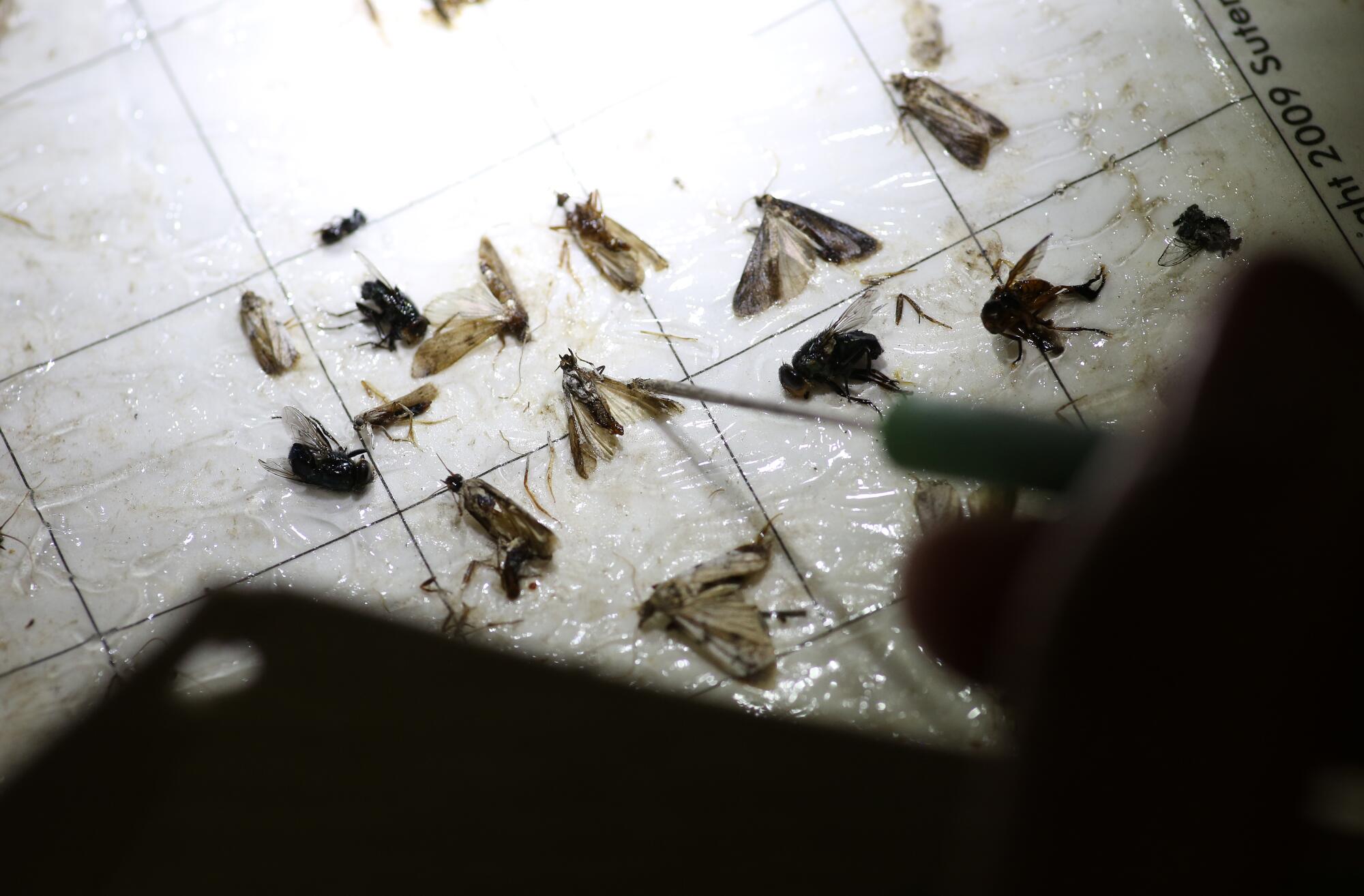
Matthew Aubuchon, national policy manager at the USDA’s Animal and Plant Health Inspection Service, estimated that the Phoenix facility could produce up to 8 million moths per day with enough staff working around the clock.
While opening more facilities in California would help, the program uses cobalt to produce high-energy radiation to sterilize the bugs — which is expensive and requires the lab to take extensive safety and security measures.
Wilson’s sci-fi shack at Kearney might hold a solution that is cheaper and easier to scale.
Instead of using cobalt or other radioactive materials, Wilson’s team uses an X-ray machine to irradiate the pests. (Unlike a radioactive substance, an X-ray machine will not emit radiation when it is turned off.)
Then, the team puts their X-rayed bugs and the sterilized insects from Phoenix through a series of tests to determine which methods produce the healthiest, sterile moths.
The tests include gluing moths to the end of a stick suspended in the air. The stick rotates like a carousel as the moths flutter around and researchers record how well they can fly.

The researchers also place moths in a wind tunnel and release sex pheromones to see if the excited bugs are able to locate the smell. (Unfortunately for the insects, there are no potential mates at the end of the tunnel.)
While the team doesn’t yet produce enough X-rayed moths to test them in a full-blown almond orchard, they do send the Phoenix moths into their final test: releasing them into their seven-acre almond farm on the Kearney campus to see how good they are at actually finding fertile moths to mate with.
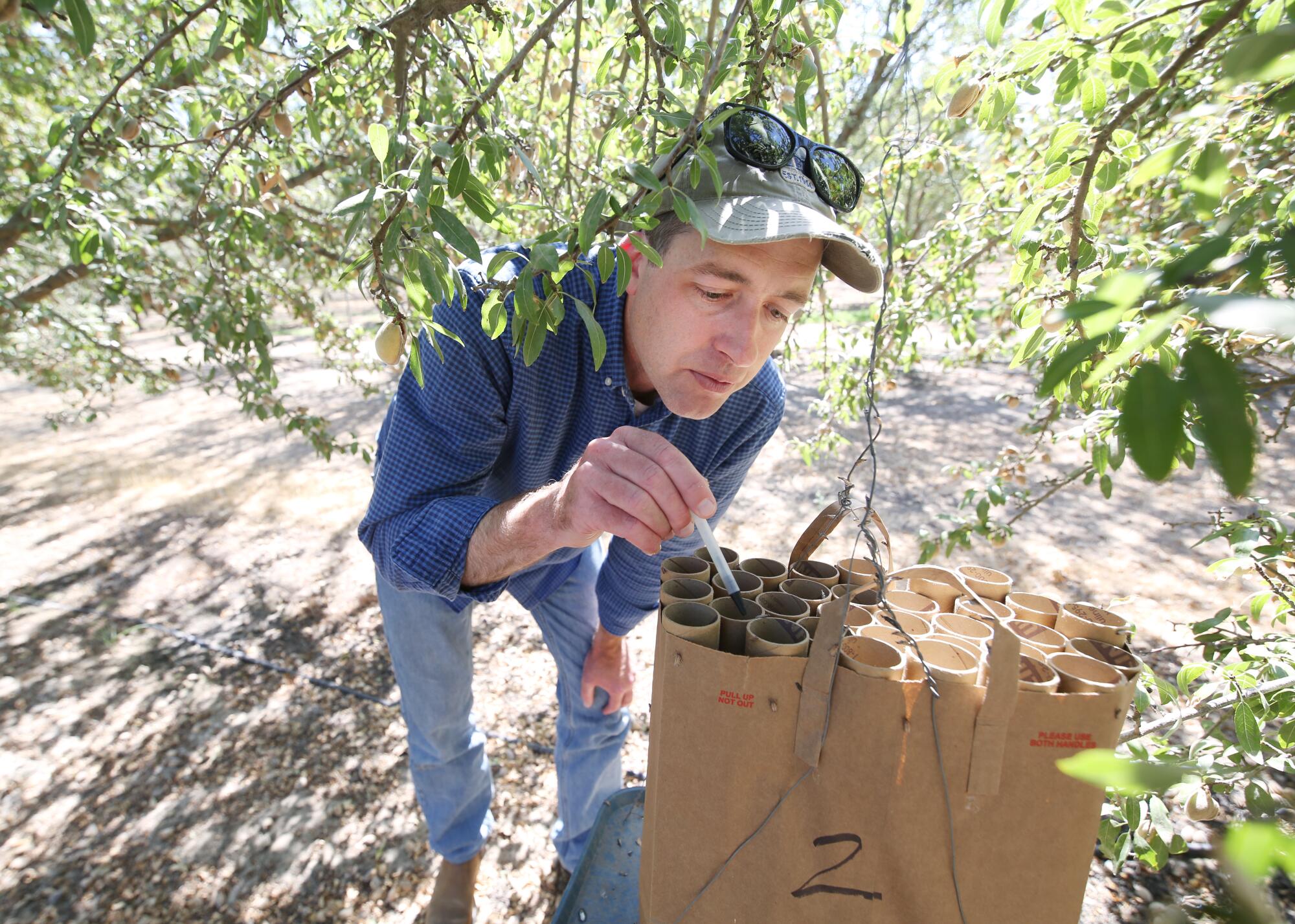
The researchers at Kearney may be in a race against time, however.
Scientists say it’s possible that climate change will continue to tip the weather in the moths’ favor. The metabolism of navel orangeworms — like many agricultural pests — is tied to temperature. The hotter it is, the faster they grow and reproduce.
A 2021 study found that the moths, which can have life cycles as short as just one month, may be able to squeeze in another generation each summer before holing up in nuts for the winter.
“For each additional generation, their population is increasing at an exponential rate,” said Tapan Pathak, an author on the study and a professor at UC Merced.
“If this additional generation is coinciding with … harvest,” Pathak said, “then they become unmarketable. That’s a huge economic loss.”
However, the food web is complicated, and just because the warmer weather benefits the moths on paper doesn’t mean the moths will end up on top.
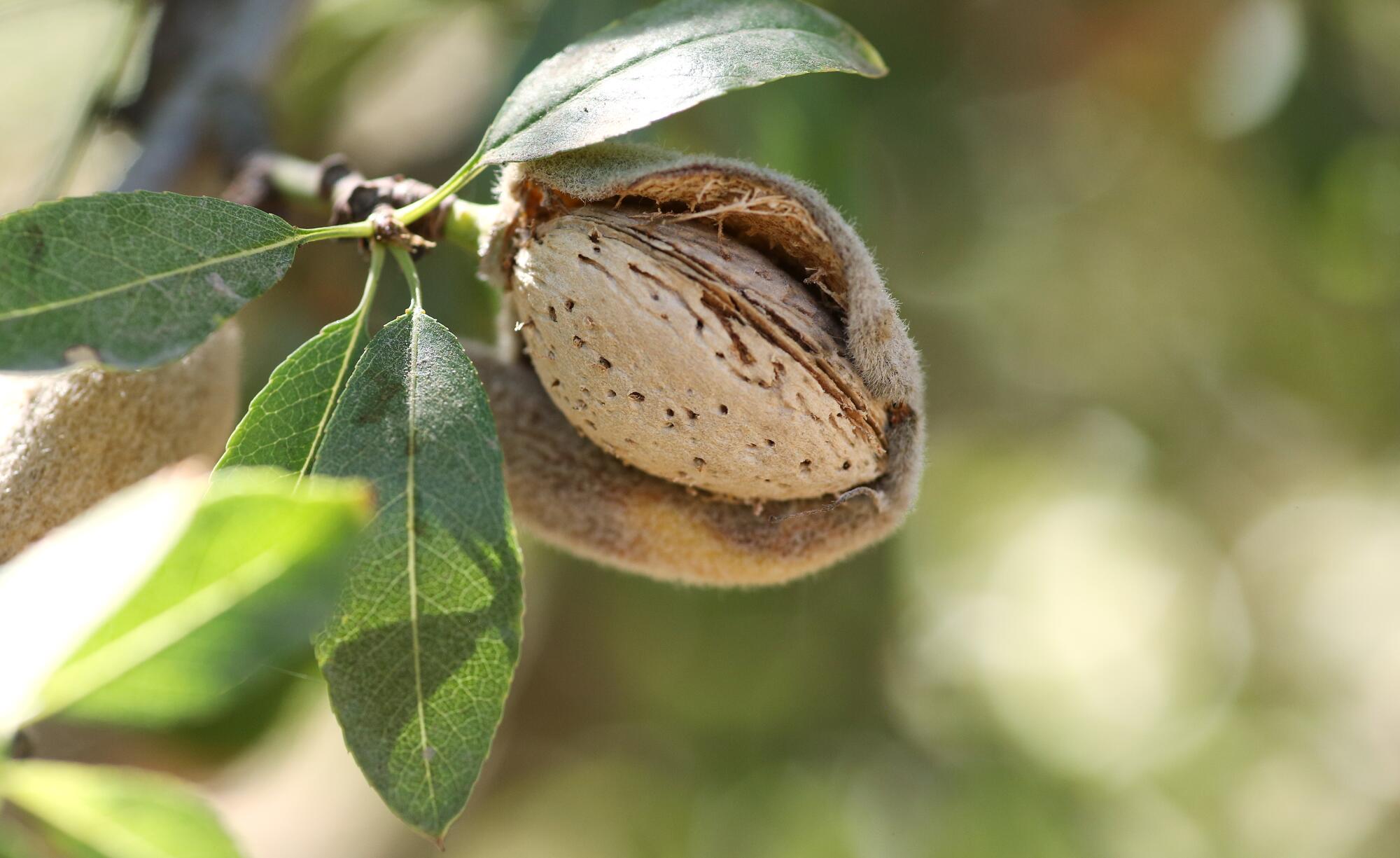
“Navel orangeworm could be a nightmare … but it could also become less of a problem because all the things that eat it benefit more from the heat than the navel orangeworm,” said Haviland. “The crystal ball is certainly not clear enough to know what will happen.”
Researchers stress that successful pest control will require multiple measures.
“What we’ve learned through integrated pest management is that the timing of one or staggering of different approaches together yields results for the growers,” said Aubuchon.
The tried-and-true non-pesticide method growers have been using since the moths’ unannounced arrival in the 1940s is to simply ensure all the almonds are either harvested or destroyed by the time winter arrives.
But for this method to be effective, there must be no more than two almonds left on every tree in an orchard. This can be hard to achieve in wet weather.
Rain makes almond branches soggy and flexible, which makes it hard to snap nuts off using an industrial shaker. Damp earth can also make it difficult for machines to get close to the trees.
Instead, workers must use poles to knock almonds off manually. As effective as this is, increasing labor costs mean some farms just can’t afford it.
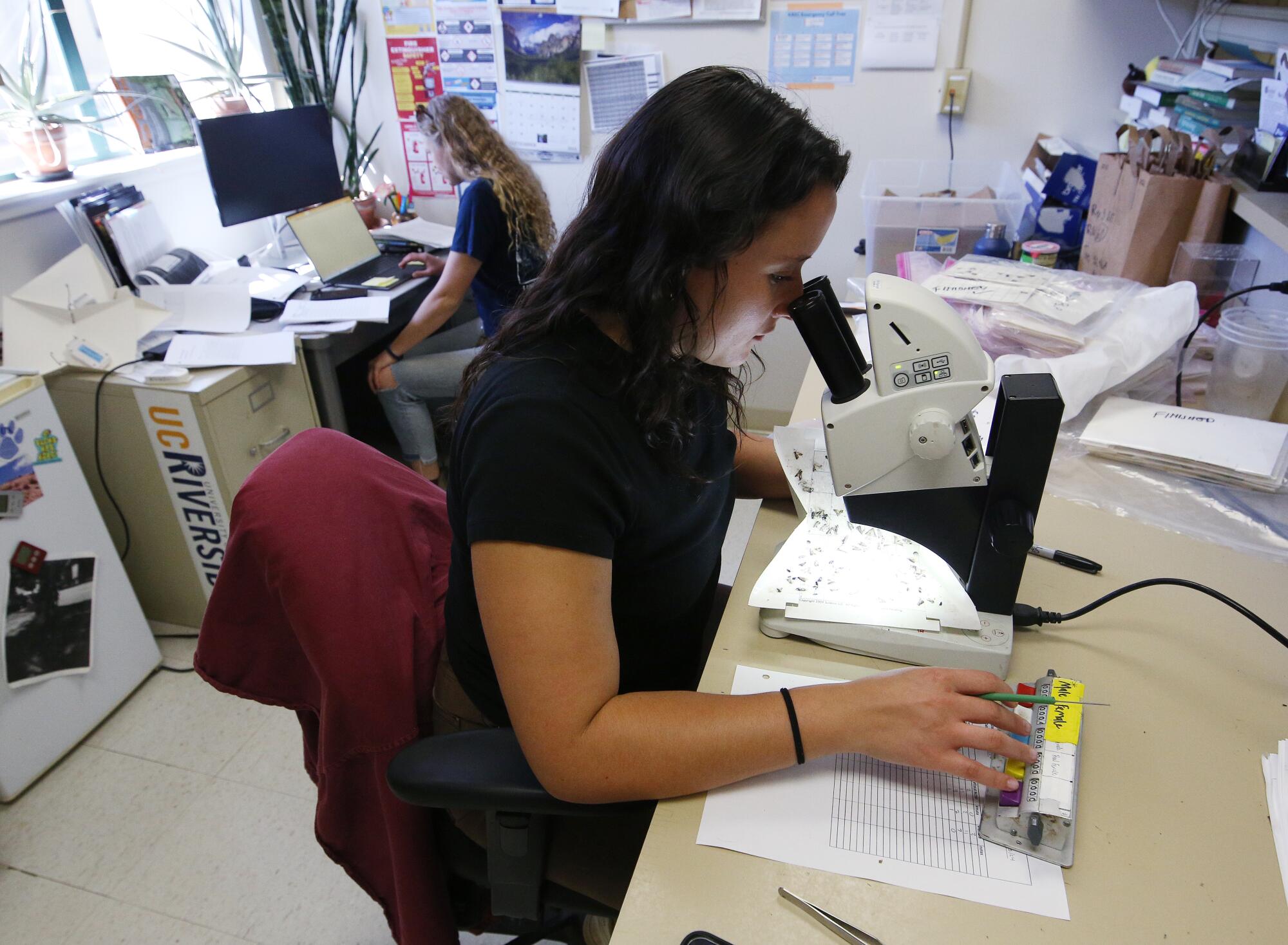
While researchers say the sterile insect technique still has a lot of hurdles to clear before it will be widely effective, they say it holds great promise.
“You’re literally managing a pest by preventing it from being born in the first place,” said Haviland of both sterile insect technique and pheromone mating disruption. “To think that something like that was possible 10 or 15 years ago — nobody could imagine that growers would be using such innovative techniques as those.”









